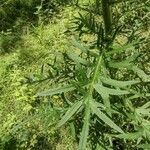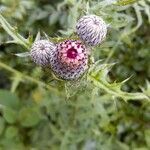Biennials, 30–230 cm; taproots fleshy. Stems single, erect, villous with septate trichomes or glabrate, distally sometimes thinly tomentose; branches few–many, ascending. Leaves ovate to broadly elliptic or obovate, 15–55 × 4–20 cm, deeply pinnatifid, to 7/8 to midribs, lobes linear to lanceolate, acute to acuminate, irregularly few toothed or lobed, main spines 2–3 mm, abaxial faces thinly tomentose or glabrate, villous with septate trichomes on the veins, adaxial faces thinly pilose; basal usually absent at flowering, petioles spiny-winged, bases tapered; principal cauline petiolate or sessile, gradually reduced distally, bases sometimes ± clasping, not decurrent; distal cauline bractlike with narrowly linear lobes, often spinier than the proximal. Heads 1–many in ± open corymbiform or paniculiform arrays. Peduncles 0–15 cm (sometimes overtopped by distal cauline leaves, not subtended by involucre-like ring of bracts. . Involucres ovoid to broadly cylindric or campanulate, 1.7–3 × 1–3 cm, arachnoid. Phyllaries in 8–12 series, strongly imbricate, dull green with darker subapical patch, ovate (outer) to linear-lanceolate (inner), abaxial faces with narrow glutinous ridge, outer and middle appressed, bodies minutely spinulose, apices obtuse to acute, spines erect (sometimes appearing as spreading in dry specimens), 0–0.5 mm; apices of inner phyllaries straight or ± flexuous, flattened. Corollas lavender or purple (white), 16–32 mm, tubes 7–15 mm, throats 4.5–10 mm (noticeably wider than tubes. , lobes 4–8 mm; style tips 3.5–5 mm. Cypselae dark brown, 4.5–5.5 mm, apical collars yellow, 0.3 mm; pappi 12–20 mm. 2n = 20, 21, 22, 23, 30.
More
Coarse biennial with several stout roots, 5–20 dm, branching and many-headed when well developed, villous or arachnoid when young, later glabrescent; lvs deeply pinnatifid into lanceolate or oblong, entire, lobed, or dentate segments, only weakly spiny, often very large, to 5.5 × 2 dm, sometimes thinly tomentose beneath, otherwise arachnoid-hirsute to subglabrous; invol 2–3.5 cm, multiseriate, its bracts ± tomentose, especially marginally, generally with a glutinous dorsal ridge, innocuous or with a vestigial spinule up to ca 0.5 mm, the inner commonly with loose, crisped tips, but not expanded; fls purple, pink, or deep lavender, rarely white; achenes 5 mm; 2n=20. Swamps and bogs, wet meadows, and moist woods and thickets; Nf. to Sask., s. to Del. and Mo. and in the mts. to N.C. and Tenn., and irregularly to Fla. and Tex. July–Oct.







